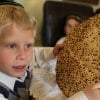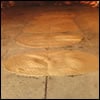It is a mitzvah that the Passover matzot be made specifically for the purpose of fulfilling the obligation to eat matzot on Passover, as the verse (Exodus, 12:17) states: You shall guard the matzot. The matzah must be guarded to ensure that it does not become chametz; matzah which was not guarded may not be used on Passover.
How do we "guard" the matzah used on Passover?
From the time that the wheat is taken to the mill to be ground into flour, it is kept under careful supervision to make sure that it does not come into contact with water or other moisture. We check it to ensure that the wheat is clean and whole.
The grinding, packing, and transporting of the wheat from the mill to the bakery is done under close supervision, to ensure that the ground wheat does not come into contact with water, and all of the utensils used for processing the wheat must be clean and dry.
The wheat is not baked on the same day on which it was ground, for it is still warm from the processing and would therefore ferment and become chametz more rapidly. It is watched while it is being kneaded to ensure that this is not done near an oven or open window which is exposed to the sun, lest the dough become hot and ferment quickly.
The water which is used to make the dough is also specially prepared and guarded. All the utensils and machinery used for preparing the matzos starting from the sifters used on the flour must be clean and smoothed every hour so that no crumbs from a previous batch of dough are mixed with a new batch.
There are numerous other precautions which are to be observed while kneading and preparing the dough, and also regarding placing it into the oven to bake. The sole purpose of these measures is to fulfill the mitzvah of matzah.
Since ordinary matzah is guarded, in the manner which we have described, from the time that the wheat is ground, in what way does it differ from the matzah which we refer to as shmurah, guarded. Matzah shmurah refers to matzah made from wheat which is guarded from the time that it is harvested. Many authorities maintain that one can fulfill the mitzvah of eating matzah on the first night of Passover only by using matzah shmurah.
What comprises the extra precautions in the "guarding" of shmurah matzah?
The wheat is reaped before the sheaves have completely dried out, for once the wheat is completely dry, it does not draw water from the ground and if it becomes wet because of precipitation, it may ferment and become chametz even though it is still attached to the ground. The wheat kernels are carefully examined to make sure that there are no grains which have split or that are sprouting, and the harvest is carefully supervised to make sure that it does not become damp until it is ground into flour.
Most authorities maintain that it is sufficient to guard the wheat from the time it is ground, in order to use it to fulfill the mitzvah of eating matzah. Some authorities dispute this, however, and maintain that the wheat must be guarded from the time that it is harvested.
Therefore, those who are very stringent in their observance of the mitzvot and on Passover this is more common than during the rest of the year are careful to use only matzot that have been guarded from the time of harvesting.
Many people make a point of eating matzah shmurah at least at the Seder, on the first night of Passover, and outside the Land of Israel, on the second night as well, for it is then that there is an obligation to eat matzot. There is no obligation to eat matzah during the remaining days of Passover.







Join the Discussion